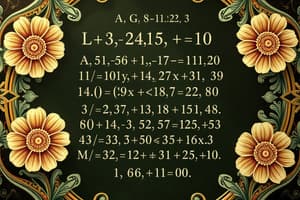Podcast
Questions and Answers
What do absolute value signs serve as equivalents to?
What do absolute value signs serve as equivalents to?
- Braces
- Parentheses (correct)
- Square brackets
- Curly braces
A group of addition and subtraction must be performed from left to right.
A group of addition and subtraction must be performed from left to right.
True (A)
A group of multiplication and division operations must be performed from right to left.
A group of multiplication and division operations must be performed from right to left.
False (B)
What is a linear equation?
What is a linear equation?
What is the difference between expressions and equations?
What is the difference between expressions and equations?
What are the steps to simplifying an expression?
What are the steps to simplifying an expression?
What are the two ways used to solve systems of equations?
What are the two ways used to solve systems of equations?
How do you solve an equation using substitution?
How do you solve an equation using substitution?
How do you solve an equation using combination/elimination?
How do you solve an equation using combination/elimination?
What is key to solving three equations on the GMAT?
What is key to solving three equations on the GMAT?
What is unique about absolute value equations?
What is unique about absolute value equations?
What is the procedure for solving absolute value equations?
What is the procedure for solving absolute value equations?
What is 0 raised to any power?
What is 0 raised to any power?
What is 1 raised to any power?
What is 1 raised to any power?
What are the solutions for x = x²?
What are the solutions for x = x²?
What happens to a positive proper fraction when raised to an exponent?
What happens to a positive proper fraction when raised to an exponent?
What happens to decimals between 0 and 1 when raised to an exponent?
What happens to decimals between 0 and 1 when raised to an exponent?
What is a compound base?
What is a compound base?
How do you multiply same-term bases raised to exponents?
How do you multiply same-term bases raised to exponents?
How do you divide same-term bases raised to exponents?
How do you divide same-term bases raised to exponents?
How do you add same-term bases raised to exponents?
How do you add same-term bases raised to exponents?
What does an exponent of 0 do?
What does an exponent of 0 do?
What happens when a base is raised to a negative exponent?
What happens when a base is raised to a negative exponent?
What happens when an exponent is raised to an exponent?
What happens when an exponent is raised to an exponent?
Flashcards are hidden until you start studying
Study Notes
Absolute Value and Operations
- Absolute value signs function like parentheses, indicating the magnitude of a number regardless of its sign.
- Addition and subtraction operations are performed in a left-to-right sequence.
- Multiplication and division also follow a left-to-right order.
Linear Equations and Expressions
- A linear equation features variables to the power of 1.
- Equations have an equal sign; expressions do not. Changes in equations affect both sides, while expressions maintain a constant value.
Simplifying Expressions
- Combine like terms to simplify.
- Identify a common denominator when necessary.
- Factor out common elements to simplify further.
- Cancel common factors when possible.
Solving Systems of Equations
- Systems of equations can be solved through substitution or elimination methods.
Substitution Method
- Rearrange one equation to isolate a variable.
- Substitute this variable into the other equation.
- Solve for the second variable and substitute back to find the first.
Combination/Elimination Method
- Align equations by adding or subtracting to eliminate a variable.
- Adjust coefficients as needed for ease of elimination.
- Solve the resulting equation and substitute back into the original equation for the remaining variable.
Key Strategies for GMAT
- Look for symmetries and align variables when solving three equations.
Absolute Value Equations
- Typically result in two possible solutions.
Solving Absolute Value Equations
- Isolate the expression within absolute value signs.
- If |x| = z (z > 0), consider x = ±a, creating two cases.
- Validate both solutions by substituting back into the original equation.
Powers of Zero and One
- Any number (including 0) raised to any power equals 0.
- Any number (including 1) raised to any power equals 1.
Solving for Specific Values
- The equation x = x² has solutions of either 0 or 1.
- Raising a positive proper fraction to an exponent decreases its value.
Effects of Exponents on Decimals
- Decimals between 0 and 1, when raised to an exponent, also decrease in value.
Compound Bases and Exponents
- A compound base contains variables or remains undivided into prime factors.
- Raising a compound base to an exponent expands each factor’s exponent.
Multiplying and Dividing Bases
- To multiply same base terms, add their exponents (e.g., x² × x³ × x⁴ = x⁹).
- To divide, subtract the exponent of the denominator from that of the numerator (e.g., 5⁶ ÷ 5² = 5⁴).
Adding and Handling Exponents
- Adding same-term bases involves multiplying the count by the base raised to the same exponent (e.g., 3ⁿ + 3ⁿ + 3ⁿ = 3 × 3ⁿ).
- An exponent of zero for any base results in 1.
- A negative exponent indicates a reciprocal (e.g., 3⁻² = 1/3²).
Exponents Raised to Exponents
- When an exponent is raised to another exponent, multiply the exponents (e.g., (z²)⁴ = z⁸).
Studying That Suits You
Use AI to generate personalized quizzes and flashcards to suit your learning preferences.




